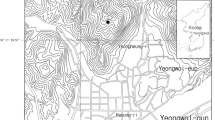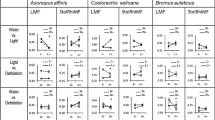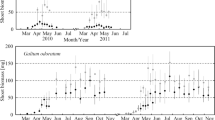Summary
Resource allocation to aerial vegetative, underground vegetative, and reproductive biomass is studied in four Chilean herbs: the annuals Chaetanthera ciliata, Erodium cicutarium, Trisetobromus hirtus, and the perennial Solenomelus peduncularis. Absolute (weight), and relative (% vegetative/total, % root/shoot) changes in biomass were determined in relation to concomitant changes in a climatic (rain regime in two subsequent years) and a microclimatic factor (spatial distribution of herbs, whether underor between-shrubs). In regard to the climatic factor, taking as basis the normal rainfall year, our results can be summarized as: 1) All herbs studied exhibit greater production in the rainy year. This is accounted for by increases in the biomass of all herbs' fractions, i.e. in aerial vegetative, underground vegetative and reproductive. 2) All annuals exhibit greater vegetative fractions (i.e. smaller reproductive fractions) in the rainy year. The perennial does not change its vegetative: reproductive balance. 3) Herbs studied exhibit contrasting responses to rainy year concerning root/shoot ratio: C. ciliata increasing it, E. cicutarium decreasing it, T. hirtus and S. peduncularis not changing it. In regard to the microclimatic factor, taking as basis the patterns exhibited by T. hirtus and S. peduncularis under-shrubs, our results can be summarized as: 1) Both species exhibit smaller production in exposed areas between-shrubs, whether in the rainy or normal year. 2) T. hirtus does not change its vegetative fraction between-shrubs neither in the rainy nor in the normal year. S. peduncularis exhibits a smaller vegetative fraction (i. e. greater reproductive fraction) between-shrubs only in the normal year. 3) Neither species change its root/shoot ratio between-shrubs, neither in the rainy nor in the normal year. Results obtained are interpreted on basis of the theory of life-history strategies.
Similar content being viewed by others
References
Avila, G., Aljaro, M.E., Araya, S., Montenegro, G., Kummerow, J.: The seasonal cambium activity of Chilean and Californian shrubs. Amer. J. Bot. 62, 473–478 (1975)
Duffey, E., Morris, M.G., Sheail, J., Ward, L.K., Wells, D.A., Wells, T.C.E.: Grassland ecology and wildlife management. London: Chapman, Hall Ltd. 1974
Gadgil, M., Bossert, W.H.: Life historical consequences of natural selection. Amer. Natur. 104, 1–25 (1970)
Gadgil, M., Solbrig, O. T.: The concept of r- and k- selections: evidence from wild flowers and some theoretical considerations. Amer. Natur. 106, 14–31 (1972)
Gulmon, S.L.: A comparative study of the grassland of California and Chile. Flora 166, 261–278 (1977)
Hickman, J.C., Pitelka, L.F.: Dry weight indicates energy allocation in ecological strategy analysis of plants. Oecologia 21, 117–121 (1975)
Keeley S.C., Johnson, A.W.: A comparison of the pattern of herb and shrub growth in comparable sites in Chile and California. Amer. Midl. Natur. 97, 120–132 (1977)
MacArthur, R.H., Wilson, E.O.: The theory of island biogeography. Monographs in population biology. Princeton, N.J.: Princeton Univ. Press. 1967
Montenegro, G., Rivera, O., Bas, F.: Herbaceous vegetation in the Chilean matorral: Dynamics of growth and evaluation of allelopathic effects of some dominant shrubs. Oecologia 36, 237–244 (1978)
Mooney, H.A., Ed.: Convergent evolution in Chile and California. Stroudsburg, Penn.: Dowden, Hutchinson, Ross, Inc. 1977
Mooney, H.A., Dunn, E.L., Shropshire, F., Song, L.: Vegetation comparisons between the mediterrean climatic areas of California and Chile. Flora 159, 480–496 (1970)
Mooney, H.A., Kummerow, J., Johnson, A.W., Parsons, D.J., Keeley, S., Hoffmann, A., Hays, R.I., Giliberto, J., Chu, C.: The producers, their resources and adaptive responses. In: Convergent evolution in Chile and California (H.A. Mooney, ed.), pp. 85–143. Stroudsburg, Penn. Dowden, Hutchinson, Ross, Inc. 1977
Newell, S.J., Tramer, E.J.: Reproductive strategies in herbaceous plant communities during succession. Ecology 59, 228–234 (1978)
Parsons, D.J., Moldenke, A.R.: Convergence in vegetation structure along analogous climatic gradients in California and Chile. Ecology 56, 950–957 (1975)
Pianka, E.R.: On r and k selection. Amer. natur. 104, 592–597 (1970)
Sierra-Rafols, E.: Analog tree and shrub species. In: Chile-California scrub atlas (N.J.W. Thrower, D.E. Bradbury, eds.), pp. 129–143, Stroudsburg, Penn.: Dowden, Hutchinson, Ross, Inc. 1977
Sokal, R.R., Rohlf, F.J.: Biometry. San Francisco: W.H. Freeman, Co. (1969)
Stoutjesdijk, P.H.: Micrometeorological measurements in vegetation of various structure, I, II, III. Proc. K. Ned. Akad. Wet. 64C(2), 171–207 (1961)
Thrower, N.J.W., Bradbury, D.E., Eds.: Chile-California scrub atlas. Strougsburg, Penn.: Dowden, Hutchinson, Ross, Inc. 1977
Author information
Authors and Affiliations
Rights and permissions
About this article
Cite this article
Jaksić, F.M., Montenegro, G. Resource allocation of chilean herbs in response to climatic and microclimatic factors. Oecologia 40, 81–89 (1979). https://doi.org/10.1007/BF00388812
Received:
Issue Date:
DOI: https://doi.org/10.1007/BF00388812




